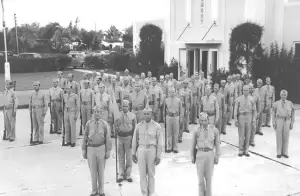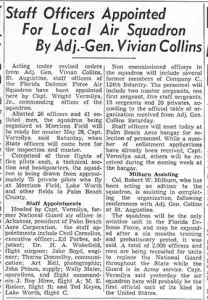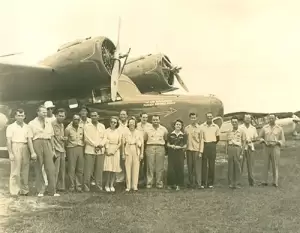Civil Defense: Florida Defense Force

In 1941 Governor Holland and the Florida Legislature created the temporary Florida Defense Force (FDF) to replace the state’s National Guard, which was in federal service during World War II. Enlistees were recruited by the State Defense Council Division of Labor and Personnel. The state supplied the men with grey uniforms and military surplus arms and equipment. Although they committed to three years, eligible males could still be called by the military draft. Enlistees received the same pay and allowances as Florida National Guardsmen, if and when their unit was called into state service.

Each county could establish its own FDF unit if at least 50 qualified men signed up, age 18 to 63. In West Palm Beach, Company E, 7th Battalion formed at the National Guard Armory building, now the Armory Art Center. The commander, Captain Richard D. Hill, coordinated with the Palm Beach County chapter of the Florida Defense Council, which was responsible for civilian defense in the area. The First Radio Company was later added to the local FDF under Captain George P. Aldridge of the City of Lake Worth’s defense council to provide communication. The squadron also included technical, headquarters, engineering, and photographic sections.
The Florida Defense Force’s air arm, the First Air Squadron, was mustered in on May 28, 1941, at Morrison Field commanded by Major Wright “Ike” Vermilya, Jr., then president of Palm Beach Aero Corporation, the airport’s fixed base operator, the primary provider of services to clientele. Fifteen local pilots patrolled the coast for German submarines, or U-boats, in about 27 assorted small planes, nicknamed “puddle jumpers.” Although all the aircraft were owned by the pilots, each had “1st Air Squadron, Florida Defense Force” painted on both sides of the nose. All officers were required to be licensed pilots, which most of them were, or to have at least one year of military service. In addition to routine coastal patrol, at times the squadron assisted with search-and-rescue missions. The state authorized additional flights from other locations in September 1941, although the headquarters remained in West Palm Beach under Vermilya.
On December 1, 1941, six days before Japan attacked Pearl Harbor, the U.S. Office of Civilian Defense authorized formation of a national Civil Air Patrol, with Vermilya as Florida commander. Along the east coast, the mission was essentially what the First Air Squadron was already doing: anti-submarine patrols. Coastal Patrol Base 3 was established with 67 members at Morrison Field on March 30, 1942, but soon moved to a small airport in Lantana. Their experiments were quickly recognized as an effective defense system for the entire east coast and the Gulf of Mexico. Other missions, including target towing for the Signal Corps, were all carried out from Lantana by Coastal Patrol Base 3.
As U.S. involvement in the war seemed imminent, the federal government had built Lantana Airport as a reliever facility for Morrison Field. The first pilot to land on the new pavement was Charles Weeks, Jr. in 1941, who had also been the first civilian licensed under President Roosevelt’s Aviation Expansion Program at Morrison Field. Palm Beach Aero Corporation and Gulf Oil erected a large hanger and installed wells and septic systems. The War Department leased the entire airport for the duration of World War II, basing several observation planes there andbuilding temporary facilities. After May 8, 1945—Victory in Europe (VE) Day—the airport took on a civil flight school catering to Veterans Administration training. The Civil Air Patrol is still active at Lantana Airport, where Group Five Headquarters operates a youth program.
In mid-1943 the Florida Defense Force was renamed the Florida State Guard, which was disbanded in 1947 after the Florida National Guard returned to state service. Measures taken by civilian patrols from both air and land proved extremely effective, and attacks by German U-boats came to an end in 1943.
Aviation Expansion
In a special message to Congress on January 12, 1939, President Franklin D. Roosevelt advised that the threat of a new war required an improved air force. In April, Congress allocated the $300 million requested by Roosevelt to expand the Air Corps, for purchasing planes, new personnel, training facilities, and bases.


